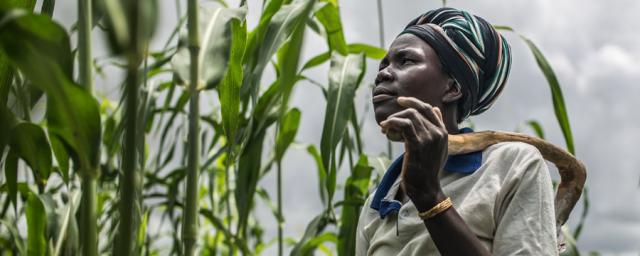
60 million people are facing a food crisis but the public has not heard about it. This is roughly the same as the number of refugees in the world, and is also a global phenomenon. But the crisis has not made the headlines because it was a slow, creeping disaster.
The 2015/16 ‘super El Niño’, combined with climate change, brought severe droughts and flooding to people in the Horn of Africa, Southern Africa, Central America, Asia, the Caribbean and the Pacific. 31.1m people are currently food insecure in the Horn of Africa1.
But, what does hunger have to do with climate change? A lot.
 Pascaline from Pissila community, in Burkina Faso, is growing sorghum. Burkina Faso suffers an extreme, variable climate: the same area can be affected by both flooding and drought within only a few months. Photo: Pablo Tosco/Oxfam
Pascaline from Pissila community, in Burkina Faso, is growing sorghum. Burkina Faso suffers an extreme, variable climate: the same area can be affected by both flooding and drought within only a few months. Photo: Pablo Tosco/Oxfam
- Lost livelihoods: Recently, harvests and livelihoods have faltered as drought has taken hold across equatorial regions. Right now, 39 million people in Southern Africa2 do not have enough to eat, after drought has devastated several cycles of crops. Without climate adaptation strategies suited to each reality, farmers, fisherfolks and pastoralist communities face a difficult choice: to migrate in search of other livelihood opportunities or to stay and face hunger.
- Food trade and prices spikes: Even where food exists, extreme events can block main roads, railway tracks, harbors, and food cannot reach markets. Besides, extreme weather events such as the recent “super” El Niño, can wipe out entire harvests and trigger dramatic food price spikes. In July this year, maize prices in Malawi were 192 percent higher than the five-year average, and are expected to continue increasing towards the end of 20163. By 2030, 95% of maize and other coarse grains consumed in sub-Saharan Africa could come from the region itself, meaning that local climatic shocks are likely to have dramatic impacts on local production, prices, and ultimately on consumption.
 Women in search of water in Hadigala district, Siti Zone, Somali Region. 8th July 2015. Photo: Poon Wai Nang/Oxfam
Women in search of water in Hadigala district, Siti Zone, Somali Region. 8th July 2015. Photo: Poon Wai Nang/Oxfam
- Water resources: Ethiopia is suffering its worst drought for 30 years and the search for water has become more desperate: women walk for two to six hours a day just to get water, and people have to dig wells deeper and deeper to access water.
- Nutrition-health: Increased water scarcity due to climate change reduces the capacity to produce food and its quality, which has serious implications for food security, nutrition and health. In Ethiopia alone 9.7 million people are currently in need of emergency food aid. People have no choice other than to cut down on the quantity and variety of the food they eat, leading to malnutrition. Tragically, children are the hardest hit: in particular, climate change is intensifying the threat from the three biggest killers of children – diarrhea, malnutrition, and malaria.
 Habodo Gele age 35, with her baby Habiiba* (3 ½ months), and her son Saffi* age 5, at their home in Bisle, Siti zone, Ethiopia. “Until now, the drought has mainly affected animals. Today it is affecting humans. It is scary. We don’t have enough food. We get a bit of help. We are supporting ourselves.“
Habodo Gele age 35, with her baby Habiiba* (3 ½ months), and her son Saffi* age 5, at their home in Bisle, Siti zone, Ethiopia. “Until now, the drought has mainly affected animals. Today it is affecting humans. It is scary. We don’t have enough food. We get a bit of help. We are supporting ourselves.“
- Climate change as a driver of inequality: The impact of global warming and extreme weather events will be higher in the developing world. Many climate impacts will be greater in the Tropics and poor countries are least able to adapt to the changes. Women are often the hardest hit, as they are the ones left to tend small farms and families, and have fewer alternative livelihoods when crops are lost.
You can help
This food crisis shows clearly what happens when we fail to invest enough in helping communities adapt to climate change and to grow and buy enough food in a warming world. Acting early in a drought costs 40% less than acting late4. Funds are urgently needed now to support the most vulnerable communities to build their resilience to the changing climate, and to protect lives now and in the future.
1 - FSNWG monthly update: Food and Nutrition Security Situation as of September 2016.
2 - SADC, Regional Situation update on El Nino-induced drought, issue 3, 24 October 2016.
3 - FEWSNET, Malawi Food Security Outlook Update, August 2016.
4 - DFID, ‘The Economics of Early Response and Resilience: Summary of Findings’, January 2013.